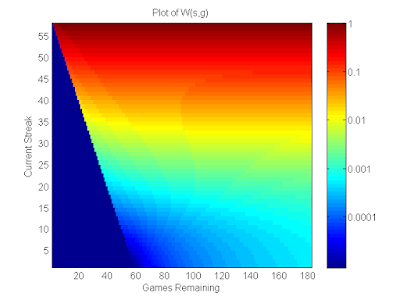Efficiently Evaluating Recursively Defined Functions
In this blog post, I will share a technique I have used in the past to evaluate linear recurrence relations
efficiently using a little bit of linear algebra. As a motivating example, assume you have a sequence of numbers that you want to know
more about: 1, 2, 3, 7, 24, 100, 448, 2051, 9444, 43549, 200889, 926770, 4275598, 19725314, 91002117, 419835526. Can you spot a pattern (hint: it's a 3rd order linear recurrence relation with constant term and a dependence on \( n \), the index into the sequence)?
Once you figure it out, check out my other blog post on finding recurrence relations from integer sequences to see if you came up with the same recurrence relation.
By this point, you have figured out \( f(0) = 1 \), \( f(1) = 2 \), \( f(2) = 3 \), and
\( f(n) = 5 f(n-1) - 2f(n-2) + f(n-3) - 2n + 1 \) for \( n \geq 3 \). Now let's say I want top compute the last \( 8 \) digits of \( f(10^{18}) \).
A naive solution would be to write a for loop, but that would many orders of magnitude too slow on modern computer architecture.
In this rest of this blog post, I will outline an approach that I take to overcome this problem, and will provide a Haskell implementation
of this approach.
While the simple simple for loop will ultimately not be sufficiently efficient, it will serve as a good starting point,
so here is a python implementation that would compute \( f(n) \) for \( n \geq 3 \) using constant memory
f0 = 3
f1 = 2
f2 = 1
for n in range(3, N+1):
f = 5*f0 - 2*f1 + f2 - 2*n + 1
f2 = f1
f1 = f0
f0 = f
print f0
{-# LANGUAGE DataKinds, TypeOperators #-}
import Data.Modular
import Data.Matrix
type IntMod = Int `Mod` 100000000
f :: Integral a => Integer -> a
f n = (_A^n * v) ! (3,1)
where _A = fromLists [[5,-2,1,-2,1], [1,0,0,0,0], [0,1,0,0,0], [0,0,0,1,1], [0,0,0,0,1]]
v = fromLists [[3],[2],[1],[3],[1]]
Ryan> map f [1..10]
[2,3,7,24,100,448,2051,9444,43549,200889]
Ryan> f (10^18) :: IntMod
78847092
map f [1..10], but I was able
to coerce it to my own custom numeric type when I called f (10^18) :: IntMod . This language features provides
really nice flexibility in these types of situations, and it's only one many reasons why I enjoy programming in
Haskell so much.
I hope that you found this blog post useful. This idea has helped me solve a handful of project euler problems,
and maybe it can help you too some day.

Comments
Post a Comment